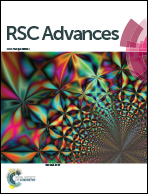Fe-assisted Ru clusters supported on porous and graphitic carbon for ammonia decomposition to COx free hydrogen†
Abstract
Porous and graphitic carbon supported Fe-assisted Ru cluster catalysts were prepared by a simple method. The textural and structural properties of the as-synthesized catalyst (Fe–C), the nearly pure carbon supported Ru catalyst (Ru/C#) and the Fe-assisted Ru catalyst (Ru/Fe–C) were characterized by X-ray diffraction, high transmission electron microscopy, Raman spectra, X-ray photoelectron spectroscopy, inductively coupled plasma-atomic emission spectrometer and N2 sorption techniques. The analysis results revealed a micro/mesoporous carbon system with high surface area, uniform pore-size distribution and high graphitization degree. The Fe-assisted Ru clusters catalysts showed significantly improved performance for NH3 decomposition compared to that of Fe–C and Ru/C# catalysts. It was concluded that Fe species not only played as a graphitization catalysts, but also promoted Ru catalysis, generating a synergistic effects during catalytic process.


 Please wait while we load your content...
Please wait while we load your content...